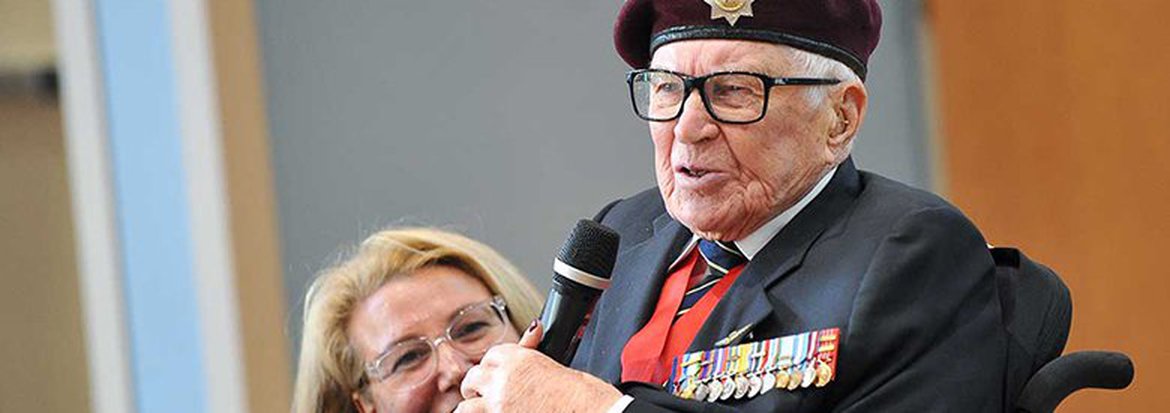Remembering the sacrifices that secured peace and freedom

2018.10.26
Major Gerald Bowen’s father lost an eye during the Battle of Passchendaele in 1917 – one of Canada’s bloodiest battles of the First World War.
His father rarely talked about the horrors of the Great War, and Bowen’s mother told the kids not to ask about the injury. He regrets not peppering his dad with more questions at the time.
But now – as the world marks 100 years since the end of the First World War – Bowen, 93, is determined to share with others what he knows about his father’s service during the war.
Canadians must never forget what our brave soldiers sacrificed a century ago in the name of peace and freedom, says Bowen, a naval reservist in the Second World War who later served with the Canadian Army in Korea, Cyprus, Israel and Lebanon.
“I fought in two wars, many battles – but I don’t think I’ve ever suffered the way those men suffered in the First (World) War,” he told a room of more than 100 veterans and dignitaries at Perley Health in Ottawa.


Sporting a burgundy beret and a black blazer adorned with service medals, Bowen helped unveil a new stamp from Canada Post honouring the 100th anniversary of the armistice that ended the fighting in the First World War.
“One hundred years is a long time. I’m glad to see that we’re remembering it because it brings back memories of my dad,” he said from his wheelchair.
“I want to thank Canada Post for dedicating and reminding people of that sacrifice 100 years ago.”

Major Gerald Bowen, a second-generation soldier whose father served in the First World War, spoke to veterans and dignitaries at the unveiling of the stamp honouring the 100th anniversary of the armistice.
The stamp depicts a dove suspended above barbed wire and includes the image of a poppy, a powerful symbol of remembrance and the principal emblem of The Royal Canadian Legion. The imagery symbolizes struggle, peace and remembrance, and honours those who made the supreme sacrifice in defence of freedom and democracy.
The stamp is cancelled in Ottawa, home of the National War Memorial, which appears on the back of the Official First Day Cover.
Canadian soldiers withstood chlorine gas attacks at Ypres, forged through heavy losses in the Battle of the Somme, climbed the heights of Vimy Ridge, captured Passchendaele and, on November 11, 1918, entered Mons.
The Canadian Corps never lost a battle in the final two years of the war. The contributions of our soldiers turned the war’s final days into Canada’s Hundred Days. The immense sacrifice of our soldiers earned the country widespread recognition and had a profound impact on Canada.
Canadian soldiers sacrificed everything in the First World War “in order to preserve something greater than themselves,” Veterans Affairs Minister Seamus O’Regan told the crowd.
“The armistice of November 11, 1918 brought about peace, unity and freedom. And that peace, unity and freedom were hard fought. Canadian and Newfoundland soldiers pressed through brutality never before imagined,” O’Regan said.
“We must honour, remember and, yes, even celebrate the actions of our countrymen and women from 100 years ago because it defines who we are today.”
Jay Davis, Canada Post’s Vice-President of Engineering, said the Corporation is proud to be Canada’s storyteller through its national stamp program. The armistice stamp honours a critical moment in Canadian and world history, he said.
“We tell the stories that define us as a people, and the First World War did that,” Davis said.
At the unveiling event, Thomas Irvine, Dominion President of The Royal Canadian Legion, introduced the Legion’s Bells of Peace initiative in partnership with Veterans Affairs Canada. At sunset on November 11, the Parliament Hill carillon and bells at Legion branches and spiritual centres across the country will ring 100 times to mark the sacrifices of our veterans and the joy that peace brought at the end of the war.
Moments after the stamp unveiling, five peals from the HMCS Carleton naval bell echoed through the room and officially launched Bells of Peace, as several veterans bowed their heads.
“We will honour those who served in the Great War and will promise their descendants that we will never forget their sacrifices,” Irvine said.
After more than four years of horrific trench warfare, fighting in the First World War came to an abrupt end at the 11th hour of the 11th day of the 11th month of 1918. The armistice signed earlier that morning in a railway car near Compiègne, France, silenced the guns on the Western front and brought relief to the world that had never before seen such a conflict.
But victory came at a terrible price. Of the more than 650,000 Canadians and Newfoundlanders who served with the Allies, more than 66,000 were killed and 172,000 wounded.
The armistice stamp is available in postal outlets and on canadapost.ca

